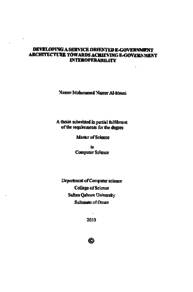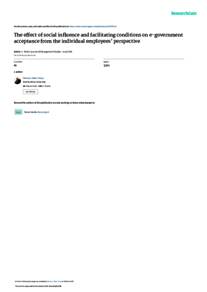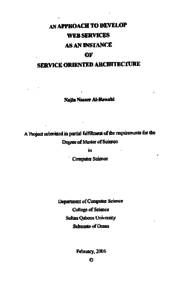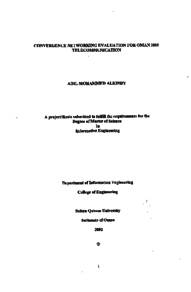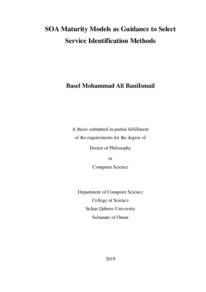Document
Developing a service oriented e-government architecture towards achieving e-government interoperability
Publisher
Sultan Qaboos University
Gregorian
2013
Language
English
Subject
English abstract
E-Government continues to be recognized as a key strategy for improving the effectiveness of governmen services. It enables citizens, and government ministries to interact with one another through a new electronic channel that is unconstrained by the locations and schedules. However, realizing this vision is strictly based on the ability of multiple, independent and quite diverse computing systems owned and managed by different government ministries to be able to interact together across all ministerial boundaries. This ability is known as e-government interoperability. Achieving e-Government interoperability is not an easy task because ministries have built their computing systems independently that produce solutions relevant to their particular needs but without adequate attention to the need to interact (connect, exchange and re-use data) with other ministries systems. This results in a patchwork of heterogeneous computing solutions that have limited coherence and largely are uncoordinated. During the last few years, e-Government Interoperability has been an important research area in order to facilitate the seamless exchange of information across governmental ministries computing systems. To this direction, several approaches have been proposed through the adoption of standards or through architectures. However, merely adopting these approaches would be insufficient since these approaches are theoretical solution and/or technical focused and have their own limitatons. Whereas, e-Government interoperability has different software system levels to interoperate with other software system(s) associated with several strong barriers on the road to its achievement. Therefore, this problem requires more practical solution. In order to achieve e-Government interoperability this thesis presents an architecture and a methodology to help establishing interoperability in e-Government. Also, an interoperability framework is presented to overcome interoperability barriers and concerns. The proposed framework is inspired by other researcher's frameworks. The proposed methodology shows the main phases to follow to approach the developed service oriented e-Government architecture. This visualizes the whole e-Government low level system architecture that aims to solve the architectural problem in achieving seamless e-Government interoperability. Then, a case study is provided to demonstrate the applicability of the proposed architecture and methodology.
Description
Thesis
Member of
Resource URL
Arabic abstract
تعتبر الحكومة الإلكترونية خطوة استراتيجة لتحقيق فعالية عالية في تقديم الخدمات الحكومية. فالحكومة الإلكترونية تمكن المواطن، والمقيم، والمؤسسات في أي دولة في العالم من التفاعل و التواصل عبر نافذة إلكترونية جديدة غير محدودة بالوقت والمكان. الا أن تحقيق هذه الغاية يعتمد بشكل كلي، وتام على قدرة الأنظمة الحاسوبية الموجودة لدى الجهات الحكومية على التوافق مع بعضها البعض للعمل معاكنظام إلكتروني واحد. هذه القدرة على التوافق بين الأنظمة الحاسوبية للجهات الحكومية تعرف باسم التوافقية في الحكومة الإلكترونية الإ أن تحقيق هذه التوافقية ليس بالأمر السهل أو المباشر، كون أن أنظمة الجهات الحكومية قد بنيت على فترات زمنية مختلفة بشكل مستقل، واستخدام تقنيات، وبرمجيات، وإحتياجات مختفلة عن بعضها البعض إختلافا جذرية، وبدون أن يكون هناك أي إعتبار للحاجة إلى ربط هذه الأنظمة مع بعضها البعض أو لتبادل البيانات المشتركة معة؛ مما نتج عن ذلك أنظمة حكومية مختلفة إختلافا تاما عن بعضها، يعتريها عدم القدرة على الترابط والتوافق مع بعضها. والآن، يعتبر موضوع التوافقية في الحكومات الإلكترونية واحد من أهم مواضيع البحث العلمي في هذا المجال من أجل تيسير تبادل سلس للمعلومات والإجراءات عبر الأنظمة الإلكترونية للجهات الحكومية. وفي هذا الجانب، فقد تم بحث، واقتراح، وتطبيق عدة مناهج في عدة دول. على سبيل المثال اعتماد تطبيق المعايير على مستوى جميع الجهات الحكومية، أو إعتاد أبنية لأنظمة الحكومة الإلكترونية. ومع ذلك، فإن مجرد اعتماد هذه المناهج لم يكن كافيا لتحقيق التوافقية المرجوة في مختلف دول العالم لأن هذه المنام ما هي الا مجرد حلول نظرية ومتركزة حول التقنيات فقط. في حين أن تحقیق التوافقية في الحكومة الإلكترونية يتطلب مراعاة مستويات مختلفة للتوافقية بين الأنظمة ليست تقنية خسب، وهذه المستويات التي يجب تحقيقها مرتبطة بالعديد من المعوقات التي تحول دون ذلك، والتي بالتالي تتطلب حلا عمليا أكثر شمولية وفاعلية. وعليه، ولتحقيق التوافقية المرجوة بين أنظمة الحكومة الإلكترونية بشكل أكثر تنظية وفعالية، جاءت هذه الرسالة لتقدم بنية متكاملة للحكومة الإلكترونية، وتقدم منهجية تقود لتحقيق البنية المقترحة بطريقة منظمة ومتدرجة خطوة بخطوة. كما أن هذه الرسالة تقدم إطارا جديدا لتعريف التوافقية في الحكومة الإلكترونية مبني على التجارب والمقترحات السابقة للباحثين في هذه المجال. وفي النهاية فإن هذه الرسالة تقدم دراسة الحالة واقعية بين الأنظمة الحكومية في سلطنة غان من أجل تطبيق المنهجية، والبنية المقترحة لأجل إثباتها عمليا.
Category
Theses and Dissertations

